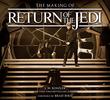TFN Review: The Making Of Return Of The Jedi By J.W. Rinzler
Review of J.W. Rinzler’s The Making of Return of the Jedi
“The point is that not that I, or any other fan, agree with every single choice that George has made in the telling of his epic saga. The point is that we care.”
–Filmmaker Brad Bird, from his foreword to The Making of Return of the Jedi
The Making of Return of the Jedi is possibly the most highly coveted work of non-fiction to come out of the Star Wars publishing pantheon in the past year. The question everyone with a spare $85.00 wants to know is, is it worth buying?
The short answer is yes, it is. This tome, like the “Making of” books that came before it, is a gargantuan, painstakingly-researched compilation of quotes, reminisces, and facts about the formation of the final film in the classic Trilogy, printed in a mammoth-sized hardback with a style that mimics Cinfex magazine while benefitting far more than that effects magazine could due to its insider knowledge.
Classic interviews, culled from dozens of sources, are mixed with new ones, as well as rare-and-never-before seen photographs, handwritten documents by George Lucas and other production people, storyboards, memos, and much more. We get special images such as the Rancor dueling (Kaiju-style) with the Verithrax Pejorative dragon from Dragonslayer (both created by Phil Tippett), conceptual drawings for various film posters that never came to be, a printed pages of a John Williams music sheet, the complete lyrics to both the “Fancy Man” (i.e. “Lapti Nek”) and “Celebration” (i.e. “Yub Nub”) songs from the original theatrical release of Jedi, and a post-Jedi letter from 11-year-old Warwick Davis to George Lucas asking for Ewok toys.
The book richly covers the time period from the beginning of conceptualization (during the filming and roll-out of Empire) all the way to the months after the May 1983 release, and it even includes an epilogue that, unlike the previous two volumes, tells where they key players are today.
That the book is a must-read for older fans is a given. Its richness and scope propels you into the logistics, problems, and atmosphere of the film as it was being made; for those of us who grew up with the Original Trilogy, it’s like stepping into the past as you see and feel the aura of the early eighties obsession and anticipation of the film wash over you. Surprisingly, the book pulls no punches when it comes to key issues: ILM’s Black Friday (in which Lucas commands his special effects army to throw out and redo key elements of the final battle), David Prowse’s rampant clashes with the press and Lucasfilm, Carrie Fisher’s remarks to People Magazine about her slave costume’s tendency to slide—everything you read back then is all here, combined with new context and hindsight.
There’s even strong emphasis placed on the depression Lucas slid into as his divorce hit, just as Jedi was destined to become a massive success and save his vision of Skywalker ranch. We even see how imperialistic Lucas became as he approved or disapproved art and shots – most of the anecdotes about the way he worked are complimentary and flattering, but in one tale, an ILM’ers perfected take of an effects shots gets the boot by Lucas to make a point – he had already approved the shot; it was “good enough” and didn’t need to be redone.
This amount of candidness for a Lucasfilm publication is refreshing. The crew’s negative views of the Ewoks, the involvement (and subsequent pulling out of the project) by proposed director David Lynch, the obviousness of Lucas’s presence overshadowing director Richard Marquand, the cast and crew’s conflicting reports of their relationship with the director-for-hire, and the comings and goings from ILM, even as it developed into a powerhouse -- it's all here, real and raw.
That the book contains omissions is also a given -- what’s not on the page is often as conspicuous as what is. While it is indeed an in-depth view of the film and those who made it—the details about the effects work, location shooting, and stars is dizzying – the book is not as definitive as it proclaims. An examination of Michael Kaminski’s The Secret History of Star Wars goes far more heavily into analyzing Lucas’ slide from self-defined small indy-house filmmaker to movie mogul and the crash of his marriage, even if the insights are more speculatory than spoken. Noticeably absent are recent comments by Gary Kurtz, apart from a mention of his departure due to the cost overruns on Empire; Kurt’s feelings about the direction of the film series– what was initially thought of and what it became during and after Empire -- have drawn strong attention in recent years, and while Lucas’s push to build Skywalker Ranch is acknowledged as the sole driver of the film sequels and merchandise revenue, the degree of this drive is less evident here than in Kaminski’s work.
Rinzler breezes by the entire "6 vs. 9 vs. 12" films issue, but for many of us (and Kurtz), this is the crux of Jedi's problem, the point where, for various reasons, many understandable, the saga went wrong--and Kaminski's book presents a far more tragic, sympathetic, personal, and realistic view of why Lucas never pursued the longer Star Wars saga that had once been promised.
Kaminski’s work also focused heavily (and fascinatingly) on the angle of the changes made to the character of Vader/Anakin; Rinzler's new book does the same, but in a different fashion, with a detailed description of the outline and first draft (pre-Kasdan) along with longer excepts from variations of the script than are found in the Kaminski book and in Laurent Bouzereau's sequentially challenged Star Wars: The Annotated Screenplays volume; here, the excerpts benefit from being viewed in chronological order, in the context of Jedi once Lucas had streamnlined his saga to six films, and with the added bonus of preproduction paintings to make sense of the ideas as they sprang forth from the minds of the creators.
The book also contains a detailed transcript of story meetings between Lucas, Marquand, and Kasdan – an incredibly rich document which, upon reading, elicits a feeling not unlike finding water in a Tatooine desert. It's the same document described by both Bouzereau and Kaminski, but here we get the actual words, not a paraphrased summary.
From this transcript, one gets a very clear picture of the changes made to Vader’s persona and to the storyline as it evolved from draft to draft: Vader’s rivalry with Moff Jerjerrod (a storyline resurrected and better utilized in the much derided Shadows of the Empire, in the form of Prince Xixor), the softening of Princess Leia, the tug-of-war about allowing a characater to die, and many more variations from the final film.
The book also shows exactly how much of the film’s final story came not from scripting, but out of Lucas’ own editing, with storylines dropped (such as the sandstorm and the rebel infiltration of the bunker on Endor) or altered (the role of Yoda and Kenobi) and added late into post production (Vader’s funeral pyre; Boba Fett's death). Storyboard elements that we’ve seen before -- elements like the skiffs, the lizard guards that eventually became Gammorean Guards, changes to the Speederbikes, two Death Stars, and the Emperor’s city home world of Had Abbadon—become contextualized and better understood.
As a result, readers are left with the impression that, whatever their misgivings about the final film, most changes were the right choice for what could be afforded—monetarily or story wise—at the time, but some ideas would have been for the better, and would have leant scope to the tale. We can also better understand Lucas’ eventual desire to change the film for its 20th anniversary, and to adopt CGI after reading of the myriad problems with puppets and practical effects, as well as those with mattes and models – even if, as Brad Bird says, we don’t agree with it.
We get insights into the invaluable role of unsung Lucasfilm staffers Rose Duignan and Aggie Rodgers, the inter-departmental rivalries of the ILM stalwarts, their frustration at having certain members locked out of the Academy Award ballots, and the lawsuit by smaller theater owners who were “locked out” of bidding for the film (Rinzler candidly admits that the outcome of this suit is not known to him).
We also get candid insights from the cast, namely Fisher, Daniels, Prowse, McDiarmid and Hamill, with the anti-Star Wars gripes of Sir Alec Guiness thrown in for good measure (Ford’s anecdotes seem to be some of his more famous and sardonic archival lines; Baker, Williams, and Mayhew feel underrepresented here). Much of these quotes are archival interviews culled from various sources, and many are those that longtime fans will recognize (the Sebastian Shaw quotes, for instance), yet most are woven so intricately into the tapestry of the take that, for the most part, they feel organic.
Rinzler's work excels at presenting the contrary nature of filming, from the tedium of the Dagobah scenes and waiting in Yuma and california (while fending off fans) to the grueling hazards of filming (the description of the filming of Jabba's palace scenes and the Sarlaac stunt double injuries are particularly traumatic). Those who think that actual filming is the glamnorous life need only read the words of the masked actors or those crammed in Jabba the Hutt's backside (with Carrie Fisher's wit thrown in for good measure).
The Making of Return of the Jedi also offers unique insight into the psyche of its director, Richard Marquand, and how he attempted to put his own stamp (and editor) onto the film, the cast, and crew, even under Lucas’ shadow. The source of the wide variances in the tone of the film – from the “Muppety” frivolity of Luke’s plan to rescue Han from Jabba, to the more somber scenes between Luke, Vader, and Palatine, becomes clear here – partially the result of Marquand’s and (later) Lucas editing, partially the result of Marquand’s attempt to “fit in” to a universe that some felt he didn’t “get,” and partly due to storytelling ideas from Marquand and Kasdan that got nixed.
These points become clear when viewed through the book’s lens at it pieces the historical puzzle together (one puzzle that still doesn’t quite get solved is the real reason for the film’s shifting title change, although Rinzler certainly makes a case about this). Despite the drama and trauma, the book ends appropriately with a look at Marquand’s ultimate contribution to the saga and his post-Jedi films before his untimely death.
The book’s presentation is similar to Rinzler's own previous "Making of" volumes: Photographic coverslip, over 350 pages, packed with photos and images of documents, storyboards, costumes, key events, and merchandise, and an engraved image in the front of the cover (once the coverslip is removed), this time of Luke’s hands holding up his lightsaber. As mentioned before, the elongated layout is similar to the presentation of effects magazine Cinefex; chapters are divided sequentially by certain dates (from February 1979 all the way until September 1987), with chapter divisions broken down by key parts of development and filming.
The text size itself is small to accommodate the vast amount of material – so small that the captions almost become a nuisance. Read cover-to-cover, as I’m sure most fans are apt to do, the binding does gain some wear. If you want a pristine book for your coffee table to flip through, the hardback is the medium for you; if you prefer to dive in and scrutinize everything (and see everything, including the tiny captions), you might be better served – and a little wealthier, with a little less eyestrain – from downloading the book to your ipad or Kindle, where you can easily enlarge text and photos, and breeze through the text in more digestible chunks.
(Caveat emptor: My device doesn’t seem to have an easy way to bookmark sections of the text, and the video links didn’t work properly, so be sure to check your devices stats carefully before you download if you go this route). I bought both the book and the download for comparison’s sake, and found benefits and drawbacks to each version.)
New to Star Wars Literature: At $85.00, this is not a great place to start with for a behind-the scenes filmmaking book unless you are a die-hard Jedi fan. For longtime fans of the series or for film buffs, this is the book for you.
Beyond the Pages: Much has been made about the videos that accompany the e-book version; everything from a blooper reel to never-before filmed scenes and outtakes (such as the one of Luke and Leia about to swing over the chasm and Harrison Ford making quips on the desert skiff). Obviously, if you’re just buying the e-book, these are a nice bonus at a great price, although many of these have popped up on the Internet, and more will, no doubt, in time. If you own the hardback but pine as a completist for the videos, then it’s only $14.95 more, but keep in mind what I said above about the ‘Net.
Also keep in mind the fact that the 2011 Blu-Ray release of the saga was nowhere near complete: even with clips and scenes we’d never seen, there were many more we knew existed, and this serves as proof, so one can surmise it is only a matter of time before we see these images compiled in another format (this insight comes from searching my feelings as someone who bought the “Behind the Scenes” CD-Rom back in the late 90s just for the Biggs scenes, which we didn’t think we’d see anywhere else—and which ended up in a much cleaner state on the Blu-rays.
Say Again?: As mentioned before, the book isn't quite "definitive". In addition, not everything about the writing is smooth. In the initial chapters, Rinzler has a tendency to info dump facts that are interesting and relevant but often choppy and out of place; it’s like he’s looking for a segment to fit in an interesting anecdote; done out of context, however, the factoids stick out as if in a void (I noticed this tendency back in the Empire volume when Rinzler presents a quote about the disappointment of the RSO Records CEO about William’s score; here there are many instances like this).
This tendency does settle down once the actual pre-production sections are over and the filming sections begin – the old Ian McDiarmid quotes, culled from several sources, and extensive in their use, really come to life as written and edited here -- but sometimes one feels like Rinzler is not given the whole story, not necessarily to hide anything, but because there are dozens of other anecdotes that are as interesting and he has to fit them all in. Perhaps this is due to his objective reporter-like style that tries not to add stylistic flourishes to an already dramatic tale; perhaps this is due to the quotes coming from longer interviews that have been available for over thirty years with their own editorial flourishes, and thus, me knowing the full context. That being said, some anecdote need and deserve a proper, longer payoff.
Fast and Furious Thoughts: Although not perfect and not quite as definitive as it purports to be, The Making of Return of the Jedi is an awe-inspiring work of research and documentation about a film of both great importance and controversy – not just in Star Wars circles, but in the realm of filmmaking as a whole. The photos, documents, script draft descriptions and story conference transcripts alone make the book worthwhile for long time fans who think they’ve seen it all; the frills of the videos in the e-book version, as well as the ease of adjusting the text size make the download an affordable way to enjoy it for those who don’t mind giving up the weightier and pricier physical manifestation. For those who fear a large-size whitewash of filmmaking, ala the original John Phillip Peeler “Making of Return of the Jedi paperback, which this book occasionally references, have no fear – you’re pretty much getting the story of the making of the film with Hutt warts and all.
Rating: 9.5/10 lightsabers
Related Stories:
TFN Review: Star Wars Art: Concept by Lucasfilm Ltd. (Foreword by Joe Johnston)
* RYL - The PT Social Thread: Best Thread Titles on the Internet
* "The Beautiful Game" - The Official JCC Football (Soccer) Thread.
* Russia: its impact on the world, its invasion of Ukraine, and its future








